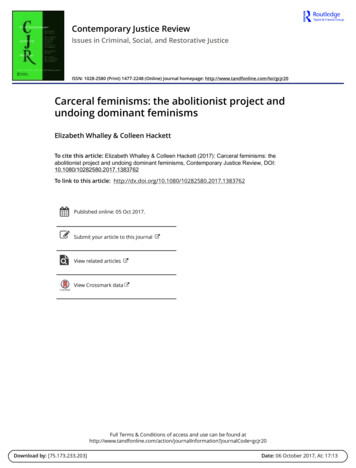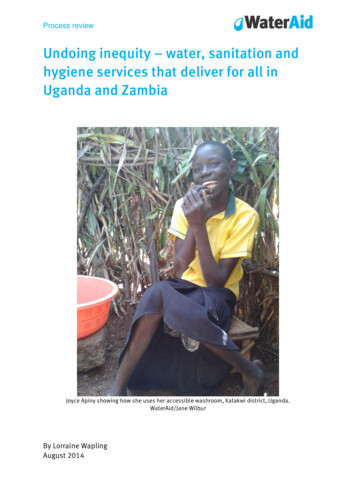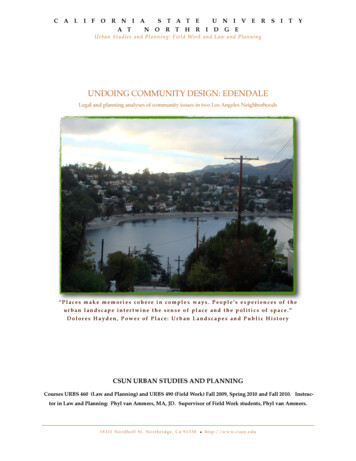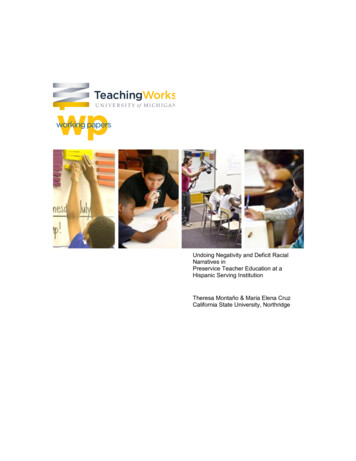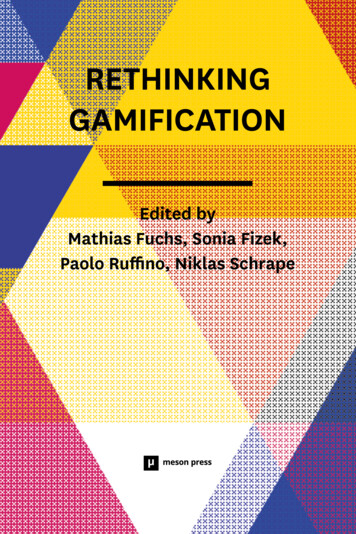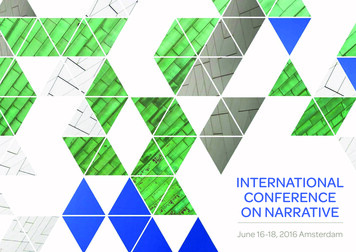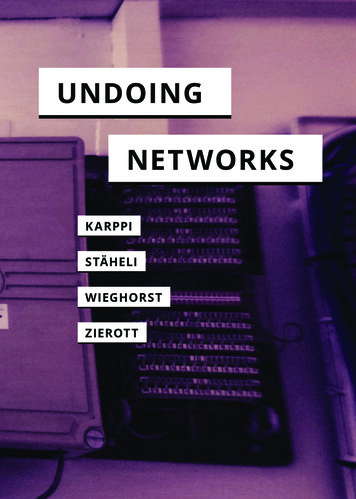
Transcription
UNDOINGNET WORKSK ARPPISTÄHELIWIEGHORSTZIEROTT
Undoing Networks
IN SEARCH OF MEDIATimon Beyes, Mercedes Bunz, andWendy Hui Kyong Chun, Series EditorsAction at a ePattern DiscriminationRemainUndoing Networks
Undoing NetworksTero Karppi, Urs Stäheli, Clara Wieghorst,and Lea P. ZierottIN SEARCH OF MEDIAUniversity of Minnesota PressMinneapolisLondonmeson press
In Search of Media is a joint collaboration between meson pressand the University of Minnesota Press.This open access publication was generously supportedby the Canada 150 Research Chairs Programand Simon Fraser University.Bibliographical Information of theGerman National LibraryThe German National Library lists this publication in theDeutsche Nationalbibliografie (German National Bibliography);detailed bibliographic information is availableonline at portal.d-nb.de.Published in 2021 by meson press (Lüneburg, Germany ) incollaboration with the University of Minnesota Press(Minneapolis, USA).Design concept: Torsten Köchlin, Silke KriegISBN (PDF): 978-3-95796-153-2DOI: 10.14619/153-2The digital edition of this publication can be downloadedfreely at: meson.press. The print edition is available fromUniversity of Minnesota Press at: www.upress.umn.edu.This publication is licensed under CC BY-NC 4.0 International.To view a copy of this license, visit: creativecommons.org/licenses/by-nc/4.0/
ContentsSeries ForewordviiIntroduction. Studies in Disconnection:On the Fringes of COVID-19ixTero Karppi[1]Undoing Networks1Urs Stäheli[2]Confusing Algorithms and Undoing Body Shapes:An Interview with Fashion Designer Nicole SchellerLea P. Zierott[3]Undoing the Outside:On Defaults and Off-Facebook ActivityTero Karppi[4]Glossary79Clara Wieghorst and Lea P. ZierottAuthors1145131
Series Foreword“Media determine our situation,” Friedrich Kittler infamously wrotein his Introduction to Gramophone, Film, Typewriter. Although thisdictum is certainly extreme—and media archaeology has beencritiqued for being overly dramatic and focused on technologicaldevelopments—it propels us to keep thinking about media assetting the terms for which we live, socialize, communicate, organize, do scholarship, et cetera. After all, as Kittler continued in hisopening statement almost thirty years ago, our situation, “in spiteor because” of media, “deserves a description.” What, then, are theterms—the limits, the conditions, the periods, the relations, thephrases—of media? And, what is the relationship between theseterms and determination? This book series, In Search of Media,answers these questions by investigating the often elliptical “termsof media” under which users operate. That is, rather than producea series of explanatory keyword-based texts to describe mediapractices, the goal is to understand the conditions (the “terms”)under which media is produced, as well as the ways in which mediaimpacts and changes these terms.Clearly, the rise of search engines has fostered the proliferationand predominance of keywords and terms. At the same time, ithas changed the very nature of keywords, since now any wordand pattern can become “key.” Even further, it has transformedthe very process of learning, since search presumes that, (a) withthe right phrase, any question can be answered and (b) that theanswers lie within the database. The truth, in other words, is “in
viiithere.” The impact of search/media on knowledge, however, goesbeyond search engines. Increasingly, disciplines—from sociology toeconomics, from the arts to literature—are in search of media asa way to revitalize their methods and objects of study. Our currentmedia situation therefore seems to imply a new term, understoodas temporal shifts of mediatic conditioning. Most broadly, then, thisseries asks: What are the terms or conditions of knowledge itself?To answer this question, each book features interventions bytwo (or more) authors, whose approach to a term—to begin with:communication, pattern discrimination, markets, remain, machine,archives, organize, action at a distance—diverge and converge insurprising ways. By pairing up scholars from North America andEurope, this series also advances media theory by obviating theproverbial “ten year gap” that exists across language barriers dueto the vagaries of translation and local academic customs and inorder to provoke new descriptions, prescriptions, and hypotheses—to rethink and reimagine what media can and must do.
IntroductionStudies in Disconnection:On the Fringes ofCOVID-19Tero KarppiThere is a certain sense of strangeness to write the introduction toa book on undoing networks in voluntary self- isolation.1 The onceopen and connected world is suddenly disconnected and physicallymore separated than ever before. National borders are beingclosed, international travel is banned, people are encouraged— orsometimes forced with the threat of a fine— to seek shelter or stayhome, employers are moving work to internet platforms to avoidphysical meetings, and many universities around the world havetransitioned from teaching in- person classes to online environments. The cause of this situation in the spring of 2020, as mightgo without saying, is the outbreak of the coronavirus COVID- 19,whose symptoms include dry cough, shortness of breath, fever,and even deathly pneumonia.2 While the mortality rate estimatesdiffer from source to source and country to country, emergencymeasures are being put in place at local, regional, national, andglobal scales to help healthcare systems cope with the outbreak.First identified in the Wuhan area of China in December 2019, thenovel coronavirus quickly went global. To anyone for whom viralityhad become associated with social media and a certain businesslogic where “money” follows “social influence as it spreads across a
xnetwork” (Sampson 2012, 2), COVID- 19 provides a timely reminderabout the epidemiological traces of virality. The rapid spread of thevirus shows that networks, whether physical or virtual, can give riseto an uncontrolled, wild, and even destructive form of connectivity.“[N]etworks,” as Alexander Galloway and Eugene Thacker (2007, 6)point out, sometimes “carry with them the most nonhuman andmisanthropic tendencies.” By March 11, COVID-19 was recognizedas a pandemic by the World Health Organization. Due to therapid spread of the virus, disconnection, evasion, isolation, andavoidance became the new social norm, and online connectionsthe preferred mode of social interaction. While we may be donewith physical networking (at least for a while), we are not donewith networks. In fact, as a form of “biological network,” “emerginginfectious diseases . . . are highly dependent on one or more networks” (Galloway and Thacker 2007, 90). The virus spreads withinnetworks, and network models are used to explain how COVID- 19becomes contagious; epidemiology and machine learning attemptto model and anticipate its movements. If virality thrives withinnetworks, predicting the edges and cutting the nodes can be a wayto bring it under control.The control of networks and our personal connectivity with themhas been one of the key topics of the recent scholarly discussionon the practices and theories of disconnection. The emergenceof this nascent field we call here disconnection studies is conjoinedwith the rise of social media and other technological platforms ofnetworked connectivity that have normalized the digital (Kuntsmanand Miyake 2019, 902). The “intensification of attention economy,”the political push toward digitalization of societies and theirservices, together with trends like self- optimization have beendiscussed as reasons individuals begin to challenge the premises ofubiquitous connectivity (Syvertsen 2020, 7– 8). Studies of disconnection pay attention to users’ practices of resistance against particular digital platforms (Light 2014; Brennen 2019) but also criticize,for example, the principles of digital capitalism and exploitativedata practices underlying the existing social network models
(Bucher 2020; Natale and Treré 2020; Karppi 2018). The vectors ofdisconnection studies constitute different methodological practicesdedicated to exploring the individual and collective tactics andstrategies of living with networks from empirical research tomedia art and research creation, and find inspiration in the media- theoretical underpinnings of failures, breaks, disruptions, andstates of exception.Disconnection studies approach notions such as connectivity andpractices like networking from a direction where the interest isnot in the unity they create but quite on the contrary. “The word‘disconnection’ is a verb and implies the removal or breaking aconnection,” writes Ben Light (2014, 150) in the first book- lengthstudy of online disconnection. Breaks, disruptions, and removalsturn our attention to the meaning of making connections and thesignificance of connectivity (Sundén and Blagojević 2019, 57), aswell as to the fact that disconnection cannot exist without connections (Hesselberth 2018). The flipside of Pepita Hesselberth’s“paradox of disconnection” is of course also true: there is noconnection without the potentiality of disconnection (Hesselberth2018; Light and Cassidy 2014). Connections are always fragile andneed to be sustained, maintained, and managed (Strathern 1996,523; Karppi 2018).As Gilles Deleuze (1989, 280) famously defined, theory is “a practiceof concepts” that interferes with other concepts coming fromdifferent practices. The studies of disconnection come with anarsenal of different concepts such as unplugging, unfriending, andwithdrawal; these studies unpack devices like Faraday cages, dwellinto meetings that take place in detox camps, examine practices ofdigital minimalism, and ask if digital suicide can really end the lifeof a data double (for the discussion of these notions see chapter 4).In this book, the concept of undoing provides the optics for lookingat disconnection. As part of the disconnection vocabulary, undoingis a notion that highlights activity. In his book on radical empiricism, William James (1912, 161) writes that “any apprehension ofsomething doing, is an experience of activity.” For James, doing isxi
xiia form of bare activity and “the sense of ‘life’” is constituted by theexperience of changes taking place (James 1912, 161). Somethingdoing indicates activity, and without activity there is nothing(Massumi 2011, 1). Erin Manning (2015, 55) argues that “whensomething does, new relational fields are forming, and with them,new modes of existence.” Undoing is not the negation of doing buta more specified activity where the change taking place is oftenevoked as resistance (Deutsch 2007, 122). The dictionary definitionof “undo,” for example, is to untie, unfasten, or loosen, and it canindicate a process of canceling or reversing results. Undoing usesthe power of what Karen Barad (2007, 175) has called an “agentialcut”— a temporal separation that reconfigures parts in an assemblage. The impacts of undoing range from responsive to critical andeven to the extreme of destructive.The project of this book is to examine and even draw such cuts,to undo what different connections and network models aredoing to our experiences, and to ask how networks appear whenapproached from angles that challenge and reverse the constitutive order of the past two decades: to connect. The intention ofthe following passages of this introductory essay is to think someof the core ideas of disconnection studies by reflecting what theCOVID- 19 has done to our tendencies to connect. As pointed outby Adi Kuntsman and Esperanza Miyake (2018, 903– 4), studies ofdigital disengagement too often conflate the social with the digital.The pandemic forces us to revise and undo some of the ties thatbind these two notions together.Let us thus begin in medias res, by mapping the specificities of thissituation as it is unfolding in spring 2020. First of all, the pandemic makes clear that disconnection is not an exclusively onlinephenomenon (Light 2014; see chapter 1 in this book). Since thevirus spreads through any physical network consisting of humans,the only way to slow it down and prevent it from affecting at- riskpopulations is to cut off all physical contact. Children are not supposed to meet their grandparents; the sick are supposed to remainindoors. Practices like quarantine and self- isolation disrupt our
daily practices and force us to determine which connections arereally necessary, which may be disregarded, and which should beavoided completely. “Connection and disconnection are dynamicprocesses that are constantly under re- negotiation,” as Anne Kaunand Christian Schwarzenegger (2014) argue.Studying disconnection means exploring and theorizing how tothink both with and beyond the dominant imaginaries of connectivity. If connectivity is about putting things to work by mobilizingthe “forms, dynamics, and spatial parameter of operations,” thendisconnection is expressed in the forms of “stillness, waiting, andde- intensification” (Tellmann, Opitz, and Stäheli 2012, 210– 11).When networks fail, we are left balancing between a sense of “helplessness and the desire for control” (Paasonen 2014, 703). In April2020, many basic services have been reduced, air travel is possibleonly in special circumstances, no one knows when daycares andschools will reopen. Goods still move but people remain in place.The virus has driven financial markets into a state of crisis. We canonly wait in this disconnected state.We are all in this together, as politicians, the press, and expertsdeclare, but our positions are hardly equal. Disconnection studiesraise questions about the capital, labor, and knowledge needed towithdraw. While networking has long been a central skill in manyprofessions, only the introvert seems to thrive in social isolation(see chapter 1 in this book). The ability to disconnect demandssocial capital in the form of networks that exist outside socialmedia (Portwood- Stacer 2013), particular skills (Syvertsen 2018),knowledge (Kaun and Treré 2018), and is sometimes a luxuryof the few and reflective of their positions of power (Karppi andNieborg 2020).In the pandemic, working from home is encouraged, though noteveryone has this privilege. Among the first to feel the impact ofthe recession were the airlines, whose job had been to connectpeople, countries, and continents. Essential workers, such ashealth care workers and first responders, cannot work from home.xiii
xiv“Long- standing systemic health and social inequities have put somemembers of racial and ethnic minority groups at increased risk ofgetting COVID- 19 or experiencing severe illness, regardless of age,”research by Centers of Disease Control and Prevention (2020) in theUnited States shows. People with lower income and for examplenew immigrants are being affected by the pandemic more adversely (CBC News 2020). Those whose income depends on the new gigeconomy cannot withdraw; they keep bringing food and goods topeople who order them online from the relative safety of isolation.In the virus era, whether biological or computer- based, everyoneis made responsible for not only keeping themselves safe butalso ensuring the safety of others (Parikka 2007). Practices ofdisconnection render self- regulation visible and make it normative(Jorge 2019). A prime example of the new normal associated withdisconnection is the practice of “social distancing.” “Put simply,”the New York Times explains, “the idea is to maintain a distancebetween you and other people— in this case, at least six feet.That also means minimizing contact with people. Avoid publictransportation whenever possible, limit nonessential travel, workfrom home and skip social gatherings— and definitely do not go tocrowded bars and sporting arenas” (Mandavilli 2020). A sign on thegate of a closed public park in Toronto, Canada, declares: “Practicegood physical distancing— two metres apart or about the length ofa hockey stick.” Keeping the distance of a hockey stick protects people, because COVID- 19 spreads via respiratory droplets producedfrom coughing or sneezing. The practice of social distancing hasbecome one of the key symbols of the preventive measuresgovernments, organizations, and individuals are taking against thethreat of COVID- 19 infection. Other symbols include face masks(see also chapter 2 on privacy wear), hand sanitizers, and toiletpaper, which quickly sold out or moved to the black market. Peoplein masks now appear everywhere in public— in airports, schools,parks, and restaurants— if they are not closed already.Social distancing, self- isolation, quarantine, and states of exceptionhave only intensified what Gilles Deleuze once defined as the
old modes of control, associating them with Michel Foucault’snotion of disciplinary mechanisms. We are witnessing the revivalof techniques of enclosure that are based on spatial partitioningand physically separating people from each other (Deleuze 1992;Foucault 1979, 195– 200). Different guidelines continue to be implemented by nation- states in order to “flatten the curve” and ensurethat each of their own health care systems can manage its patients.To slow down the spread of the virus, anyone who has been intouch with an infected individual or has traveled in high- risk areasis asked or forced to self- isolate for fourteen days. Those whoexhibit signs of infection are placed in quarantine.Disconnection constitutes not only a break but “also a state inwhich something can exist in” (Light 2014, 150). Social distancing,quarantine, and self- isolation all protect us from the virus. Amongother countries, Finland declared a state of emergency, whichgranted juridical rights to limit the size of any meetings— first to nomore than five hundred and soon to no more than ten participants.New rules and restrictions go into effect every day. Restaurantsoffer only takeout. Gyms, hairdressers, beaches, and many otherpublic spaces are forced to close indefinitely. Being “corona free”is now a selling point on Tinder. Individuals are voluntarily carvingout their own isolated zones where new social norms apply: nohugging, no touching, no forms of physical contact. In the pandemic, life itself is being protected by disconnection.Nation- states try different tactics to control the pandemic, fromnudging the citizens’ social behavior toward more socially distantinteractions to closing the borders to noncitizens (see also chapter 3on nudging). One critic of the exceptional measures taken by certainnation- states is Giorgio Agamben (2020a; 2020b). In response,Jean- Luc Nancy points out that “exception” is not an anomaly but is“becoming the rule in a world where technical interconnections of allkinds (movement, transfers of every type, impregnation or spreadof substances, and so on) are reaching a hitherto unknown intensitythat is growing at the same rate as the population,” and the role ofthe government is just one small piece of the puzzle (Nancy 2020).xv
xviWhen Foucault wrote about the exceptional measures taken tocontrol the plague at the end of the seventeenth century, by separating contaminated spaces and people from those perceived to behealthy, he also highlighted the role of practices such as classifying,registering, and reporting that emerged alongside (Foucault 1979,196– 97). Virus discourses, both biological and computational, thatfocus on the threats and vulnerabilities subsisting in connectionseem inseparable from the practices that shaped the networkculture in the 1990s (Parikka 2007, 94– 96; McKinney and Mulvin2019). Similarly, the responses to Covid- 19 are accompanied bya development of new digital practices designed to control therisk of contamination. Mark Andrejevic and Neil Selwyn describe“how smartphones can be repurposed as monitoring systems tosupport the management and control of the public,” for instance,by forcing everyone to download an app that lets individuals knowwhether they can leave their apartments (Andrejevic and Selwyn2020). In Germany, Deutsche Telekom is giving out smartphonelocation data for tracking the movements of the general public andmaking predictions about the spread of the virus (Schaer 2020). InMay, Apple and Google introduced an automated “contact tracing”system where smartphones via Bluetooth connect automaticallywith other phones in proximity.3 The recorded information aboutthe time and space of contact can then be used to warn the ownersof the possible exposure to the virus. If social networks werebased on establishing digital connections for users to stay in touchwith their existing networks of friends, colleagues, or people theyshare interests with, regardless of their physical time and location,COVID- 19 brings forward its reverse image. In the new world, thesocial is determined by the digital, which undoes physical socialnetworks by dictating when, where, and with whom you can stay intouch and who are to be isolated from their peers.COVID- 19 is a variation of a “corona” virus, which was given thisname because its shape exhibits a fringe projection resemblingthe rarefied gaseous envelope of the sun or other stars. In thepandemic era, physical connections are precisely the ones that
are rarefied, and disconnection is no longer a fringe projection.While techniques of social distancing may succeed in physicallyisolating people from their offline environments, isolation doesnot necessarily extend to online spaces. Quite the contrary, manydaily practices that used to happen face- to- face, from meetings toteaching and doctor’s appointments, are now being moved online.From playdates to after- work meetings, people are forging newsocial relations online. Those who left Facebook now considerreturning in order to find a sense of community in self- isolation.Teleconferencing apps like Zoom, Skype, and FaceTime have takenon renewed significance. Newer social networks like Nextdoorare becoming places where people can seek and offer local help.For many, disconnecting from physical social circles amplifies theimportance of their online counterparts.In quarantine, social life plays out primarily online, where “socialdistancing” is a misnomer. In recent years, internet researchershave repeatedly shown that online connections can be very realand personal, and that physical distance in an era of digital mediano longer amounts to social isolation (Baym 2010). In fact, the concept preferred over “social distancing” by experts such as the WorldHealth Organization is “physical distancing,” since the clear spatialorder of the latter is more descriptive than the vague symbolismof the former. In a pandemic, physical disconnection becomes apragmatic state of life itself.When Alexander Galloway and Eugene Thacker were writing aboutnetworks more than a decade ago, they were demanding that weaccount for the unhuman aspects of these networks. We are nolonger in control of even our own networks. With their emphasis onthe unhuman side of the networks, Galloway and Thacker turn ourattention to the “materiality of networks,” which “exhibits power relations regardless of powerful individuals” (2007, 153). Their centralargument is that the understanding of networks, especially digitalones, has been too human- centric, which leads scholars to neglecthow network infrastructure, exemplified by protocols, establishesthe very conditions for directing and distributing human action.xvii
xviiiThese claims have been developed and nuanced by software andplatform studies, which have tended to invest in decentering thehuman from network analysis. Today, the unhumanity of networksis expressed by the uncontrollability of biological viruses and how,from the perspective of the virus, human bodies, human touch,and even human connection are nothing more than an exploitablestructure in a contagious network.Galloway and Thacker point out that “networks operate throughceaseless connections and disconnections . . . They are foreverincomplete but always take on a shape” (2007, 156). When thehumans are decentered from the physical proximity from eachother, the power of the social takes other shapes. One place wherethe undone offline networks release their social power is onlinenetworks and different technologies of the social. Our physicalsocial networks, however, do not just move from one environmentto another, and social is not conflated with the digital withoutconsequence. Just like in the offline world, also in the online worldlife shapes and is shaped by the networks where it happens. Theproblem is that digital networks are not merely unhuman butsometimes also inhuman. Once seen as an embodiment of participatory democracy, many digital platforms have become networksfor fake news, hate speech, and “offer the most destructive forcesan ideal propaganda system” (Vaidhyanathan 2018, 195). Therevenue of these platforms is based on exploiting not only users’private information but also their behavioral patterns. Social mediaplatforms actively define “what it means to be social, and whatthey think should be filtered out as anti- social” (Carmi 2020, 121).“Overconnection” has become recognized as a real problem (Baymet al. 2020). While digital networks are clearly exploitative of humanvalue and draw new definitions for human capital, we are pushedeven more deeply into them, in the era of COVID- 19, rather thandisconnected from them. What used to be conceived as overconnection becomes the default.Before a vaccine is developed, the disciplinary mechanisms ofdisconnection are targeted toward networks; many of them are
methods of cutting links between the nodes, isolating individualsinto smaller subsets that are easier to control. Simultaneously,jobs, education, and our personal relationships move fromin- person meetings to online networks. This is a moment wherewe need studies of disconnection to make visible the in- andunhuman relations different networks make possible. But evenmore importantly, when the links are being cut, physical networksundone, and offline becomes substituted with the online, howto take care for each individual node becomes a question thatneeds to be addressed by these same studies. While Galloway andThacker once encouraged us not to define digital networks fromhuman- centric perspectives— because the human, by default, is nota central concern of these networks— human- centric perspectivesare the very ones we now need.Undoing Networks is an attempt to examine what it means to bein disconnection. What is the experience of being in the middle ofthings that break, disrupt, unfasten, and cut. In disconnection,we are faced with the activity of drawing the limits of a networkand setting its boundaries. Internet celebrities are burning out,individuals are visiting digital detox camps, policymakers areimagining how to restrict social platforms, and people seem to bemore conscious of their privacy. If the first two decades of this newmillennium were about establishing different forms of connectivityfrom the birth of social media to algorithmic recommendationsystems and the rise of the figure of the influencer, we are onlynow coming to terms with the wider cultural and political implications of this change. The downfall of the major social platformsand network models these firms have incorporated in their business strategies and of which they have been benefitting fromfor two decades is perhaps not here yet. But it feels closer thanbefore.In disconnection, one is neither with nor against the networksbut always somewhere in between. As Clara Wieghorst andLea P. Zierott note in the opening to chapter 4, “disconnection isxix
xxembedded in our everyday lives.” With its structure, this book triesto capture this embeddedness and show how our culture of ubiquitous connectivity can be challenged and its fundamentals criticizedand denaturalized from within. This introduction included, thebook is built around five distinct components that are disconnectedfrom each other methodologically and practically. The first chapterseeks for the role of the human in network theory from classicalsociological texts to the emergence of 5G networks. The secondand fourth chapters diverge from more traditional scholarly takes.The former interviews a fashion designer whose clothes are notfor visibility but for privacy. The latter adopts the keywords formatto articulate some of the nodes and edges in the network ofdisconnection studies. The third chapter undoes Facebook’s privacyproposition with a close reading of a technical feature. To followthe logic of undoing, the chapters invite the reader to a continuousprocess of connecting, disconnecting, and reconnecting.In the first chapter, Urs Stäheli argues that we need to understandthe genealogy of connectivity both within and beyond the digital. Asa first step toward a sociology of undoing networks, Stäheli tracesdisconnection back to the works of sociologists Georg Simmel andGabriel Tarde from around 1900. For Stäheli, these early formsof criticism of networking operate as performative concepts thatproduce the ways in which we now understand connectivities anddisconnectivities. In other words, notions like hyperconnectivity(the possibility of overnetworking), figures of the shy or introvertedtype (networking is too much), and the condition of schizophrenia(everything is connected) each produce an understanding ofconnectivity that exceeds its technical aspects. With each of theseseemingly individualized figures, however, Stäheli does not arguethat disconnection is a subjective problem that can be cured withdetoxes or self- care. Rather, he shows that problems of disconnection are part of the imaginaries of network culture; ratherthan being a mere corollary of connection, disconnection is thusproductive as such. This approach allows Stäheli to rework the ideaof disconnection— not as complete
Undoing uses the power of what Karen Barad (2007, 175) has called an “agential cut”—a temporal separation that reconfigures parts in an assem-blage. The impacts of undoing range from responsive to critical and even to the extreme of destructive. The project

